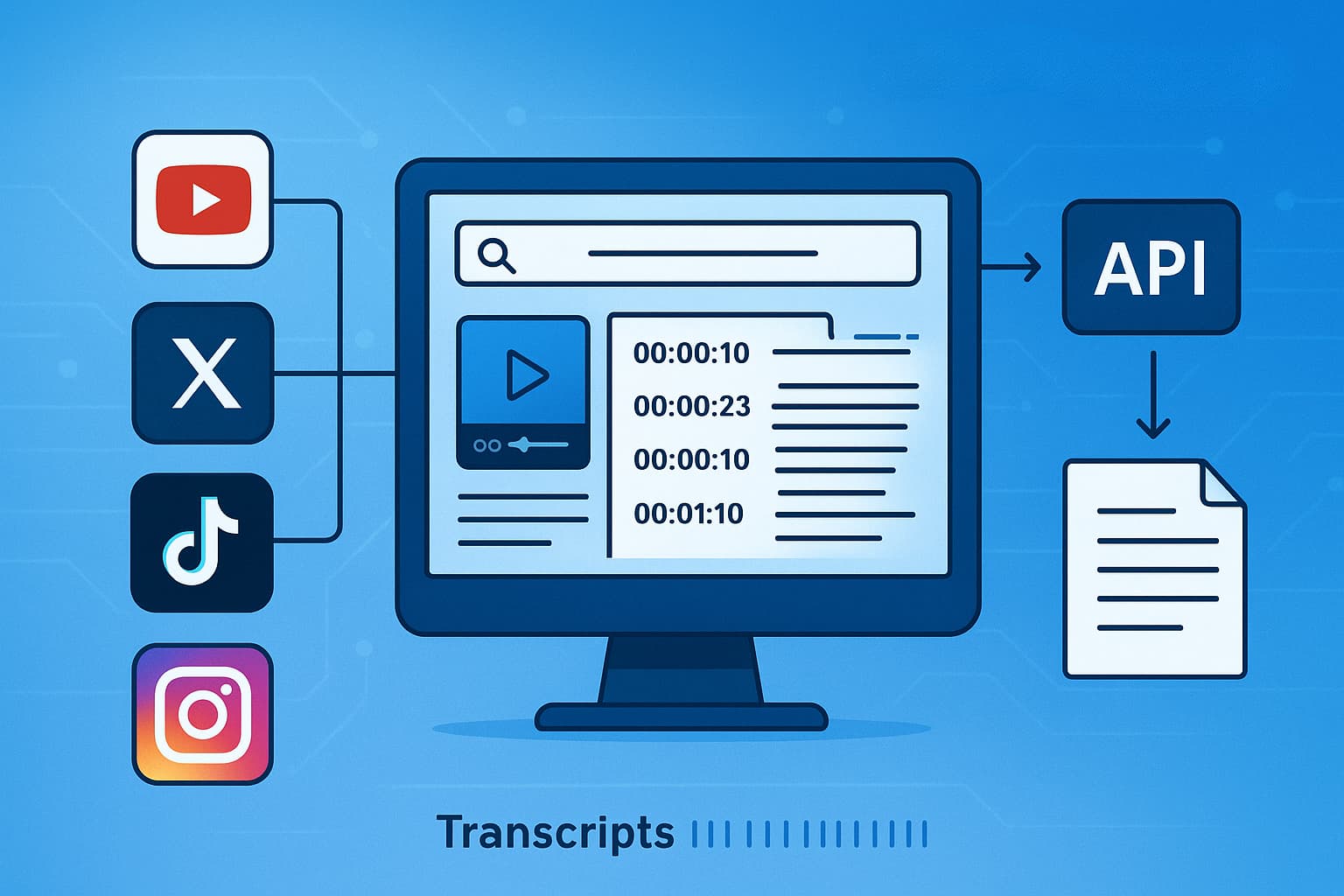A single Universal Transcript Retrieval API to fetch clean, timestamped transcripts across platforms—built for LLMs, agents, and RAG.
Universal Transcript Retrieval API: Fetch Transcripts from Any Platform
Use VidNavigator’s Universal Transcript Retrieval API to get clean, timestamped, LLM‑ready transcripts and metadata from YouTube, Instagram, TikTok, Facebook, X (Twitter), and more—returned in a consistent JSON format.
Introduction: Why this API now?
The rapid rise of large language models and AI agents has created demand for reliable, large‑scale, multi‑platform transcript access. Modern RAG pipelines need consistent structures, timestamps, and metadata across sources to ground answers in verifiable evidence.
Our aim is to remove platform fragmentation so teams can build faster. To our knowledge, this is the only large‑scale, multi‑platform transcript retrieval API that combines native caption capture with robust transcription fallback and returns a uniform, LLM‑ready JSON schema for retrieval‑augmented generation (RAG) and analytics.
Key takeaways
- One API for transcripts across YouTube, X, TikTok, Instagram, Facebook.
- Preferred Transcript API with Transcribe API fallback when captions are missing.
- Consistent JSON: text, start, end, plus rich video_info for RAG.
- Built‑in timestamps make answers verifiable and shareable.

What is the Universal Transcript Retrieval API?
It’s a single interface to programmatically retrieve (or generate) video transcripts and structured metadata across platforms. This enables reliable RAG, analytics, and search experiences without building platform‑specific scrapers.
How it works
- Transcript API: Retrieves native captions/subtitles when available and normalizes them to JSON.
- Transcribe API: Falls back to high‑quality ASR when captions are missing or for uploads.
- Uniform schema: You get consistent fields (text, start, end) plus video_info for every source.
Quickstart
Transcript API (preferred)
curl --request POST \--url https://api.vidnavigator.com/v1/transcript \--header 'Content-Type: application/json' \--header 'X-API-Key: <api-key>' \--data '{ \"video_url\": \"https://x.com/elonmusk/status/1857814606120436119\", \"language\": \"en\"}'
Transcribe API (fallback & uploads)
curl --request POST \--url https://api.vidnavigator.com/v1/transcribe \--header 'Content-Type: application/json' \--header 'X-API-Key: <api-key>' \--data '{ \"video_url\": \"https://www.instagram.com/reel/ABC123/\"}'
Python example
from vidnavigator import VidNavigatorClientwith VidNavigatorClient(api_key="YOUR_API_KEY") as vn:# Try transcript first (uses native transcripts where available)result = vn.get_transcript(video_url="https://www.tiktok.com/@user/video/123456789")print(result.data.video_info.title)# Fallback to transcribe for platforms without transcriptstr = vn.transcribe_video(video_url="https://www.tiktok.com/@user/video/123456789")print(tr.data.transcript[0].text)
Transcript vs Transcribe (when to use)
| Feature | Transcript API | Transcribe API |
|---|---|---|
| Speed | Fast (uses native captions) | Slower (runs ASR) |
| Best for | Platforms with captions | No captions or file uploads |
| Cost | Lower | Higher |
Response structure (example)
{"status": "success","data": {"video_info": {"title": "A Really Cool Video","description": "An example description for the video.","thumbnail": "https://example.com/thumbnail.jpg","url": "https://youtube.com/watch?v=dQw4w9WgXcQ","channel": "Example Creator","duration": 212.5,"views": 123456789,"likes": 987654,"published_date": "2009-10-25","keywords": ["example", "youtube", "video"],"category": "Music","available_languages": ["en", "es", "fr"],"selected_language": "en"},"transcript": [{"text": "We're no strangers to love","start": 0.5,"end": 3.2},{"text": "You know the rules and so do I","start": 3.5,"end": 5.1}]}}
Best practices for accuracy and scale
- Call Transcript API first for speed; fallback to Transcribe API when captions are absent.
- Persist transcripts to your store to power RAG and avoid repeated fetches.
- Keep timestamps to anchor answers and create shareable, verifiable links.
- Respect platform policies; cache responsibly and handle rate limits/backoffs.
Pricing & capacity
Start free. For high‑volume retrieval, use the Voyager plan or contact us for Enterprise. Credits support bursty workloads and batch backfills.
FAQs
Which platforms are supported?
YouTube, X (Twitter), TikTok, Instagram (via transcribe), Facebook, Dailymotion, Vimeo, and more.
What if a Video has no captions / subtitles embedded ?
When subtitles / captions track. Use the transcribe API to transcribe the video and retrieve the transcript. However, this is a different API usage and would consume from the number of hours of uploaded / transcribed videos you have in your plan. Please note that since most of Youtube videos have automatic captions, the transcribe API does not work for Youtube videos for now.
Can I choose languages?
This is supported for transcript API (Not the transcribe). Pass a language code (e.g "en") and if available, the API would return the corresponding track. If not, the API would return the default language.
Can I get millions of transcripts per month?
Yes. Unlike many other services, this API is intended to be used for large scale retrievals. Checkout the pricing page for more details.
Is there a YouTube Transcript API?
Yes. Use the Transcript API to retrieve YouTube captions/subtitles in a normalized JSON format with timestamps along with extra rich metadata about the video.
What are the API rate limits?
The default rate limits are 200 transcript request / minute! That's 8.6 million transcript requests per month! For higher rate limits, please contact us. For transcribe API, rate limite is at 20 request / minute. Checkout our rate limiting documentation for more details.